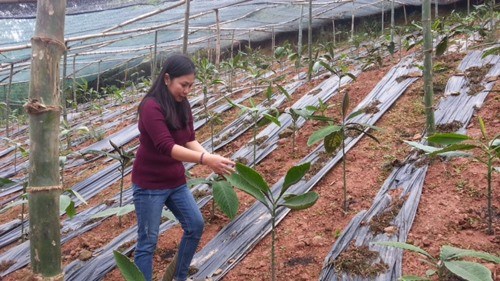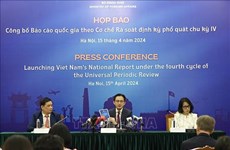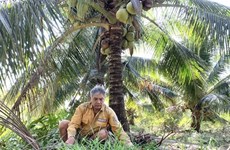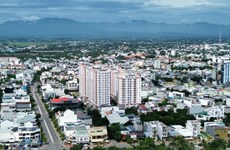Herbal plant preservation yields large profit
Net houses cover a vast hillside in Phuc Xuan hamlet of Soc Son district where thousands of plants are being grown. Each plant is marked with its name and a number.
 Owner Nguyen Thanh Tuyen in her herbal field in Bac Son Commune, Soc Son District. (Photo: hanoimoi.com.vn)
Owner Nguyen Thanh Tuyen in her herbal field in Bac Son Commune, Soc Son District. (Photo: hanoimoi.com.vn) Hanoi (VNA) - Net houses cover a vast hillside in Phuc Xuan hamlet of Soc Son district where thousands of plants are being grown. Each plant is marked with its name and a number.
Nguyen Thanh Tuyen, owner of the field, fertilises golden camellia plants grown there. She has spent several years preserving and developing the rare herbal species.
The 5ha field is divided into different zones on which 60 herbal plants are being preserved and five others developed. The golden camellia dominate, covering 4ha.
Golden camellia is a precious herbal plant. Boiling the flowers and leaves in water and drinking it is believed to help adjust body fat and blood sugar, as well as detoxifying livers and kidneys.
But since the golden camellias were discovered in the forests of Vietnam’s northern mountainous areas, they have been overexploited due to their health benefits, and as a result have gotten rarer.
“People hunted it down to sell to Chinese traders,” Tuyen said. “They went into the forests, cut down the trees and sold the seedlings.
“The plant would have become extinct if it weren’t preserved properly, so I travelled to many places to search, purchase them and bring the seedlings back here for breeding,” she said.
Her efforts paid off as there are currently 12,000 golden camellia plants of 22 types growing in her field.
Apart from golden camellias, Tuyen is preserving dozens of other herbal species, such as ardisia silvestris that is believed to cure abdominal pain and stomach diseases, and Japanese honeysuckle that helps reduce body heat, detoxify and prevent allergies.
“There are some 196 types of herbal tea around the world. I’ve got 22 of the 26 types that are grown in Vietnam,” Tuyen said.
The field is a source of safe herbal material for pharmaceutical companies, a source of sustainable income for growers and an example of environmental protection. All the plants are grown using organic methods.
“Organic fertilisers are more expensive than inorganic ones, but they have better quality and are safe for both producers and consumers,” Tuyen said.
She processed some of the plants into domestic and export products such as herbal tea, oil, hot herbal packs and herbal cosmetics. Based on the tea drinking habit of Asians, Tuyen learned to combine the plants with tea and produced eight types of herbal tea.
At first Tuyen struggled with growing the herbal field since the traditional farming techniques did not comply with the safe production process. Traditional farmers wanted quick crops, were impatient and always worried about finding outlets for their products.
However, her passion and determination to preserve and develop herbal plants charmed local residents and persuaded them to collaborate. From the original 5ha herbal field in Bac Son commune, Tuyen developed two other herbal zones in the Xuan Giang commune (5ha) and Trung Gia commune (3ha), increasing the total area of her herbal production to 13ha.
To date, all three of her production zones have been certified as having a sustainable, organic pharmaceutical production model that meets the criteria of safe soil, safe water sources and safe fertilisers certified by the Vietnamese Good Agriculture Practice (VietGAP).
In Bac Son commune, she rents lands and hires local farmers to take care of the plants, while in Xuan Giang commune she collaborates with local cooperatives, she said.
On the other hand, farmers in the Trung Gia commune collaborate with one another to help grow her plants, she added.
Trinh Hong Phong, a farmer who rents Tuyen 5ha of his land, said that his family’s livelihood has improved greatly in the last year since the rental fee is a dozen times higher than his sales from growing tea and cassava in previous years.
His family members also earn 5 million VND per month from guarding and taking care of the herbal plants, he said.
Hoang Chi Dung, chief of the district’s economic division, said that the collaboration model in which enterprises contribute capital and production technology while farmers contribute land and labour is highly efficient.
For example, the golden camellias only yield crops every five to six years, but farmers can grow other herbal flowers, generating billions of dong in revenue per ha per year, he said.
Growing herbal plants is a new direction for enterprises and farmers to expand cultivation areas and improve their lives, he added.-VNA













